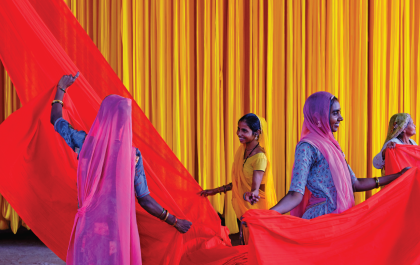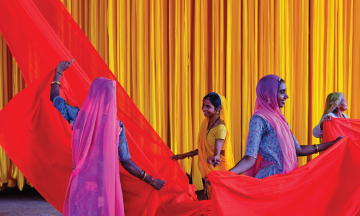As part of MW’s tribute to heritage, this segment is dedicated to the historical sculptors of Bangladesh, running until March 26
By Neha Shamim
Bengali art, a profound form of self-expression, has been a cornerstone of cultural identity since time immemorial. From ancient terracotta temples to contemporary murals, Bengalis have painted, sculpted, and carved their emotions into enduring masterpieces. Today, the younger generation carries on this legacy, turning city walls into vibrant canvases that reflect their dreams, struggles, and aspirations.
Among the myriad sculptures that stand as testaments to the resilience and creativity of the Bengali spirit, two works are particularly iconic: Aparajeyo Bangla and Shabash Bangladesh. These sculptures, rich in historical significance and artistic merit, inspire generations to honor the sacrifices and achievements of their forebears.
Aparajeyo Bangla: A Monument to Courage and Freedom
Aparajeyo Bangla, located at the heart of Dhaka University’s Faculty of Arts campus, is a prominent sculpture symbolizing the spirit of the Bengali people during the Liberation War of 1971. Designed by Syed Abdullah Khalid, the monument captures the resilience and sacrifice of the freedom fighters. The sculpture features three figures: a farmer carrying a rifle, a woman holding essentials, and a young student clutching a grenade. This composition represents the united e orts of all social groups during Bangladesh’s struggle for independence.
The project began in 1973 under the initiative of Dhaka University Central Students’ Union (DUCSU). However, political turmoil and other challenges delayed its completion. The sculpture was eventually inaugurated on December 16, 1979, coinciding with Victory Day. Notably, the models for the figures were real individuals: art student and freedom fighter Badrul Alam Benu for the farmer, Syed Hamid Maqsood Fazle for the student, and Hasina Ahmed for the woman figure.
The monument stands as an enduring emblem of liberation, inspiring students and visitors alike. Its strategic placement at Dhaka University, an epicenter of intellectual and political movements, amplifies its historical significance Today, Aparajeyo Bangla not only celebrates the sacrifices of 1971 but also serves as a cultural and educational beacon for the nation.
Aparajeyo Bangla stands as a profound reminder of Bangladesh’s turbulent history, embodying the values of courage, resilience, and unity that defined the Liberation War. It was not merely an artistic endeavor but also a historical narrative etched in stone, telling the story of how ordinary individuals became extraordinary in their fight for freedom. The farmer, woman, and student figures symbolize the active participation of all strata of society, emphasizing that the war was not fought by soldiers alone but by a nation united. The sculpture has inspired countless people over the decades, with its powerful representation of ordinary heroes resonating deeply in the collective consciousness of Bangladesh.
Shabash Bangladesh: A Salute to Valor and Sacrifice
Shabash Bangladesh, a striking sculpture by Nitun Kundu, stands prominently at Rajshahi University. This artistic masterpiece, inaugurated on February 3, 1991, pays tribute to the bravery and sacrifices of the freedom fighters during the Liberation War of 1971. The sculpture’s creation was spearheaded by the university’s central student union and remains a landmark symbol of courage and resilience.
The sculpture portrays a freedom fighter in a bold, triumphant pose, holding a rifle and raising a clenched fist. This defiant stance encapsulates the unwavering spirit of the Bangladeshi people during their fight for independence. Nitun Kundu, known for his innovative approach to public art, incorporated lines from Sukanta Bhattacharya’s poetry on the sculpture, further enriching its emotional and symbolic resonance.
Strategically placed near the university’s Senate building, Shabash Bangladesh serves as a site of historical reflection and a source of inspiration for future generations. It stands on a campus that was a hub of activism and sacrifice during the Liberation War, making the location even more significant. The design reflects a mix of simplicity and dynamism, emphasizing the raw energy and determination that defined the nation’s struggle for freedom.
Over the years, the sculpture has become a focal point for commemorative events and an enduring symbol of Bangladesh’s fight against oppression. It not only honors the past but also serves as a rallying cry for unity, justice, and independence in contemporary times. As a physical manifestation of the nation’s collective memory, Shabash Bangladesh stands as a testament to the sacrifices made by countless individuals during the Liberation War.
Bangladeshi sculptures like Aparajeyo Bangla and Shabash Bangladesh are more than just monuments; they are enduring symbols of the nation’s identity, resilience, and values. They remind us of the sacrifices made to achieve independence and the collective spirit that defines Bangladesh.
As we pay tribute to these iconic works of art, let us also celebrate the unyielding creativity of the Bengalis. From ancient terracotta to modern murals, art continues to be a powerful medium of expression, connecting generations and inspiring future endeavors. Through these sculptures, we preserve not only history but also the indomitable spirit of a nation that remains invincible.













